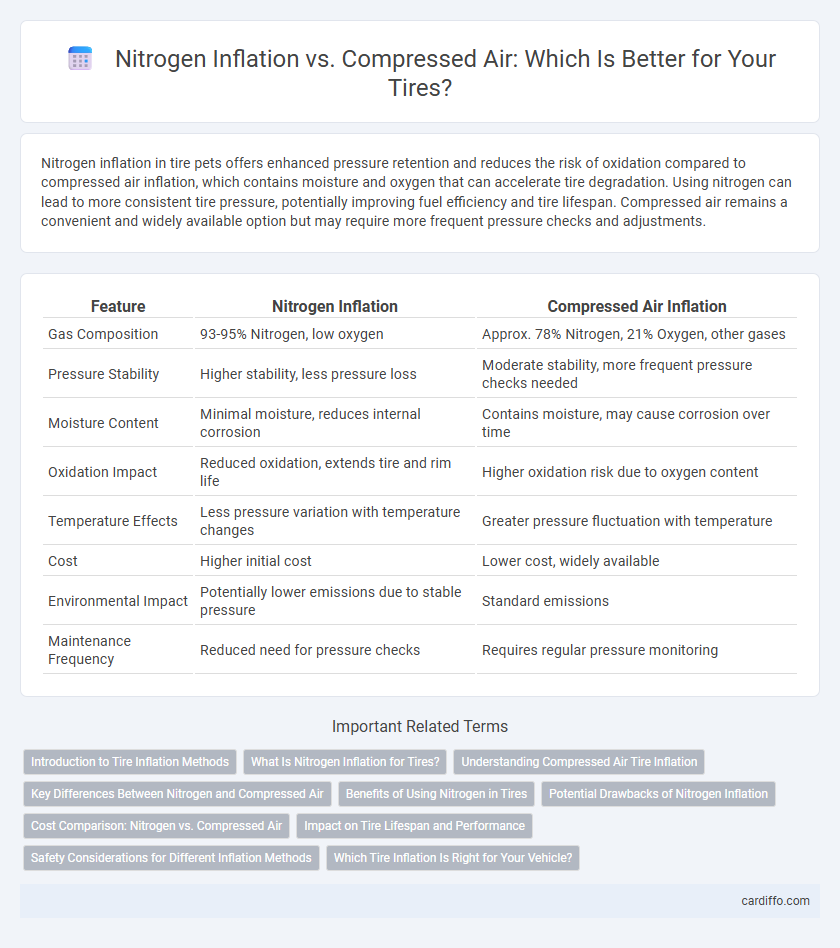Nitrogen inflation in tire pets offers enhanced pressure retention and reduces the risk of oxidation compared to compressed air inflation, which contains moisture and oxygen that can accelerate tire degradation. Using nitrogen can lead to more consistent tire pressure, potentially improving fuel efficiency and tire lifespan. Compressed air remains a convenient and widely available option but may require more frequent pressure checks and adjustments.
Table of Comparison
| Feature | Nitrogen Inflation | Compressed Air Inflation |
|---|---|---|
| Gas Composition | 93-95% Nitrogen, low oxygen | Approx. 78% Nitrogen, 21% Oxygen, other gases |
| Pressure Stability | Higher stability, less pressure loss | Moderate stability, more frequent pressure checks needed |
| Moisture Content | Minimal moisture, reduces internal corrosion | Contains moisture, may cause corrosion over time |
| Oxidation Impact | Reduced oxidation, extends tire and rim life | Higher oxidation risk due to oxygen content |
| Temperature Effects | Less pressure variation with temperature changes | Greater pressure fluctuation with temperature |
| Cost | Higher initial cost | Lower cost, widely available |
| Environmental Impact | Potentially lower emissions due to stable pressure | Standard emissions |
| Maintenance Frequency | Reduced need for pressure checks | Requires regular pressure monitoring |
Introduction to Tire Inflation Methods
Tire inflation methods primarily involve using compressed air or nitrogen to maintain optimal pressure levels and improve performance. Compressed air contains approximately 78% nitrogen, 21% oxygen, and small amounts of other gases, which can lead to pressure fluctuations due to moisture and oxygen-induced oxidation. Nitrogen inflation offers more stable pressure by reducing moisture content and minimizing oxidation, enhancing tire lifespan and fuel efficiency.
What Is Nitrogen Inflation for Tires?
Nitrogen inflation for tires involves filling tires with pure nitrogen gas instead of regular compressed air, which typically contains about 78% nitrogen, 21% oxygen, and trace amounts of other gases. Using nitrogen helps reduce tire pressure fluctuations caused by temperature changes because nitrogen molecules are larger and less likely to seep through the tire walls compared to oxygen molecules. This results in more stable tire pressure, improved fuel efficiency, and extended tire life by minimizing oxidation inside the tire.
Understanding Compressed Air Tire Inflation
Compressed air tire inflation involves filling tires with atmospheric air composed of approximately 78% nitrogen and 21% oxygen, along with trace gases. This mixture can lead to faster pressure loss and moisture buildup inside the tire, increasing corrosion risk and affecting tire performance over time. Proper maintenance is crucial, as regular pressure checks are needed to counteract air's higher permeability compared to pure nitrogen inflation.
Key Differences Between Nitrogen and Compressed Air
Nitrogen inflation offers more stable tire pressure due to larger molecule size, reducing leakage compared to compressed air, which contains smaller molecules like oxygen and water vapor causing faster pressure loss and corrosion risks. Nitrogen's dry, moisture-free properties prevent tire rim corrosion and improve tire life, whereas compressed air's humidity can lead to internal tire rust and inconsistent pressure. Performance benefits of nitrogen include better fuel efficiency and enhanced tire durability, while compressed air remains more accessible and cost-effective for regular inflation needs.
Benefits of Using Nitrogen in Tires
Using nitrogen for tire inflation reduces moisture and oxidation inside the tire, which helps maintain optimal pressure longer than compressed air. Tires filled with nitrogen experience less pressure fluctuation due to temperature changes, enhancing fuel efficiency and tire lifespan. This stable inflation can improve vehicle handling and reduce the risk of blowouts, contributing to overall safer driving conditions.
Potential Drawbacks of Nitrogen Inflation
Nitrogen inflation can lead to higher initial costs and limited availability compared to compressed air, making refills less convenient for some drivers. Oxygen removed from nitrogen-filled tires reduces moisture and oxidation, but improper sealing may still allow air ingress, negating benefits over time. Additionally, nitrogen inflation may cause uneven tire pressure if not monitored regularly, potentially affecting tire performance and safety.
Cost Comparison: Nitrogen vs. Compressed Air
Nitrogen inflation typically incurs higher upfront costs due to specialized equipment and purer gas requirements, averaging $5 to $10 per tire fill compared to compressed air's nominal or zero cost when using standard air compressors. Over time, nitrogen inflation can reduce maintenance expenses by maintaining more stable tire pressures and preventing oxidation, potentially extending tire life by up to 20%. Compressed air inflation remains cost-effective for most consumers but may result in more frequent pressure adjustments and earlier tire wear, affecting overall long-term expenses.
Impact on Tire Lifespan and Performance
Nitrogen inflation reduces tire oxidation and moisture, leading to slower tread degradation and extended tire lifespan compared to compressed air. Tires filled with nitrogen maintain more consistent pressure over time, enhancing fuel efficiency and vehicle handling performance. Reduced pressure fluctuations from nitrogen inflation also lower the risk of premature tire wear and potential blowouts, improving overall safety.
Safety Considerations for Different Inflation Methods
Nitrogen inflation reduces the risk of tire pressure fluctuations caused by temperature changes, enhancing vehicle safety by maintaining more consistent pressure levels. Compressed air, containing moisture and oxygen, can lead to corrosion inside the tire and rim, potentially compromising tire integrity and increasing the risk of blowouts. Using nitrogen also minimizes oxidation, prolonging tire life and reducing the likelihood of sudden tire failures on the road.
Which Tire Inflation Is Right for Your Vehicle?
Nitrogen inflation maintains tire pressure longer than compressed air due to its larger molecules, reducing the frequency of top-ups and improving fuel efficiency. Compressed air is readily available and cost-effective, but it contains moisture and oxygen, which can accelerate tire degradation and pressure loss. Choosing between nitrogen and compressed air depends on your vehicle type, driving habits, and maintenance preferences, as nitrogen suits high-performance or heavy-duty vehicles, while compressed air suffices for everyday use.
Nitrogen inflation vs Compressed air inflation Infographic

 cardiffo.com
cardiffo.com